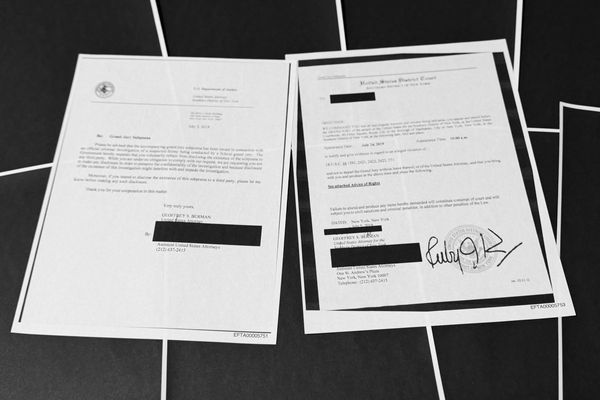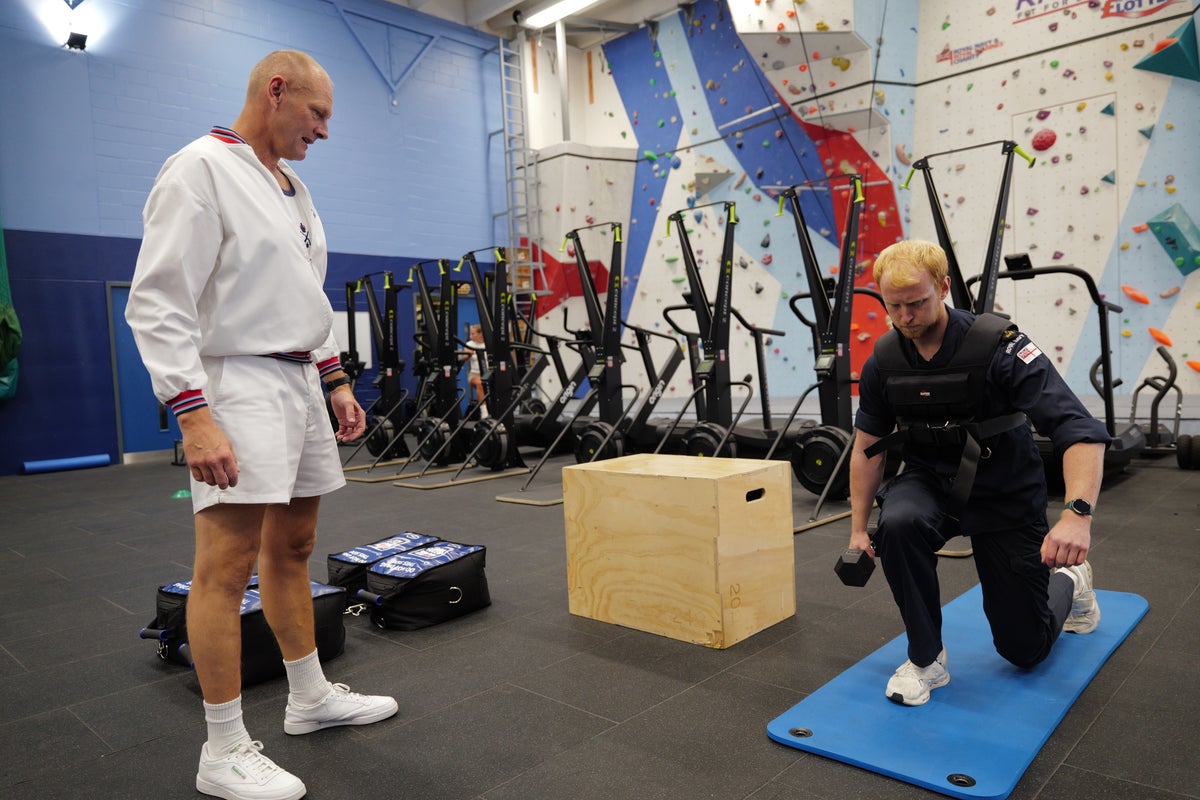
“There’s still time to back out,” Lieutenant Commander Joseph Wood informs me with a grin. I’m standing opposite an assortment of heavy sand-filled “powerbags”, wooden boxes, dumbbells, kettlebells and a weighted vest – this is the Royal Navy’s new physical employment standard (PES) test.
I’m tempted to take him up on the offer. I have 15 minutes to complete the course and – whether it’s a run, HYROX race or CrossFit workout – there’s something about going against the clock that sends my stomach somersaulting.
I glance quickly at the fire escape, but before I can conjure up any excuses Chief Petty Officer Darran Hoare – Daz, to colleagues – clicks his stopwatch and directs me to a couple of 20kg kettlebells. We’re off.
So how did I get here? It started months earlier when I emailed the Ministry of Defence asking about the fitness tests used in the armed forces. As a fitness writer, the idea was that I would give them a try in the gym, then report on my experiences.
I soon received a reply from Commander Serena Brotherton, Spokesperson at the Directorate of Defence Communications. After a bit of back and forth, her paraphrased response read: “Come to Portsmouth. Do it properly.”
How to do the Royal Navy fitness test
Last September, the Navy replaced its traditional annual fitness test of a 1.5-mile run or bleep test with a new strength-based assessment designed to more accurately mirror the demands of the job.
“If there’s a fire on board a ship, running 1.5 miles won’t help very much,” one of the officers jokes.
The new test, which is uniform across all ages and genders, is to be performed annually. It serves the purpose of ensuring all sailors have the base level of fitness needed to represent the Royal Navy. This is how to do it.
Complete the sequence below within 15 minutes:
- Kettlebell carry x60m (carrying 2x20kg kettlebells for four lengths of a 15m course, with a step over a small hurdle every 15m).
- Powerbag lift x20 (using a 20kg powerbag, and moving it between an 18in box to a 48in box – there and back is one rep)
- Kettlebell deadlift x12 (using one 40kg kettlebell, and performed to a set tempo with a three-second pause at the top of each rep – your hands cannot leave the handle of the kettlebell throughout)
- Rope pull x6m (pulling 2x30kg powerbags along uniform rubber gym flooring)
- At this point, the sailor must don a 20kg weighted vest and wear it for the remainder of the test. This represents firefighting equipment
- Lunge (standard or reverse) while holding a 7.5kg dumbbell in one hand x12
- Casualty drag x15m (drag four attached 20kg powerbags around a cone and bag again)
- Kettlebell carry x60m (carrying 2x20kg kettlebells for four lengths of a 15m course, with a step over a small hurdle every 15m)
Read more: I tried the walking method that offers ‘10 times the benefits’ of walking 10,000 steps per day
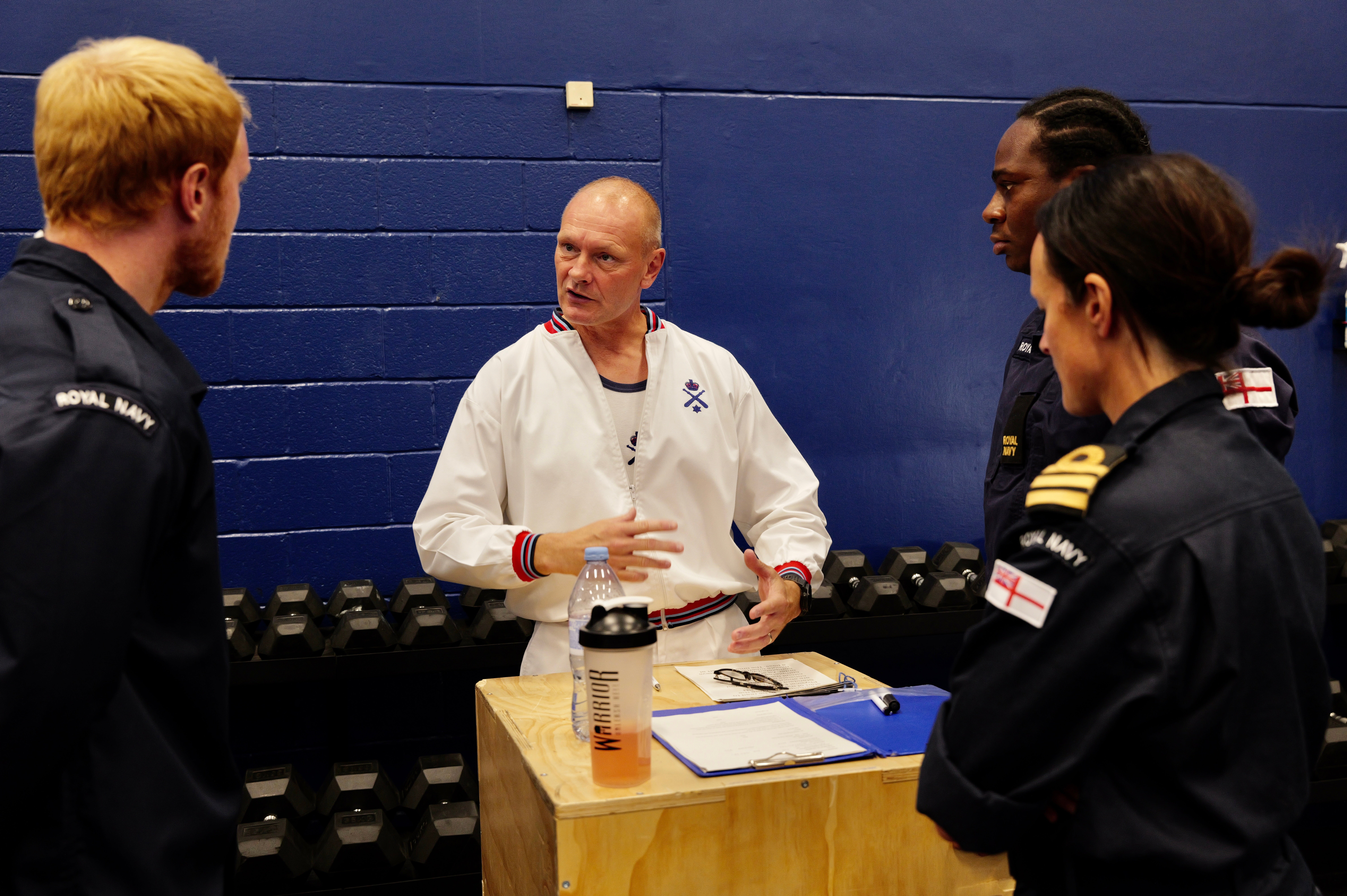
What happened when I took the Royal Navy fitness test
I turn up at HMS Temeraire, the Royal Navy’s physical training school in Portsmouth, dressed in tracksuit bottoms and a t-shirt. This is not what I will be wearing for the test.
After a discombobulating tour of the base’s maze-like hallways, I’m handed a heavy woollen uniform and directed to a changing room. Things are about to get sweaty.
From the changing room, I descend a set of stairs and emerge into a swish new gym complete with power racks, rigs, climbing ropes, curve runners and more.
“It used to be a sports hall,” I’m told. “People would play a lot of five-a-side, but in recent years we’ve found there’s a lot more demand for a gym.”
This is clear to see. It’s in constant use during my visit, with sailors choosing to fill their downtime with heavy barbells, Olympic weightlifting drills, treadmill sprints and CrossFit-style workouts.
To prepare for the test, I warm up while watching three sailors take the assessment. First is the Royal Navy’s SO2 operational fitness Lieutenant, Commander Joseph Wood – a solid figure with thick forearms that help him complete the course without breaking a sweat.
Next is Commander Serena Brotherton – a slight-yet-powerful figure who lifts the 40kg kettlebell with ease on her way to a pass. Up third, there’s a younger recruit, Able Seaman Mine Warfare Kishay Pompey. He boasts shoulders broader than my horizons and tosses the 20kg powerbag around like a beanbag – another pass.
Station one: kettlebell carry x60m (2x20kg kettlebell)
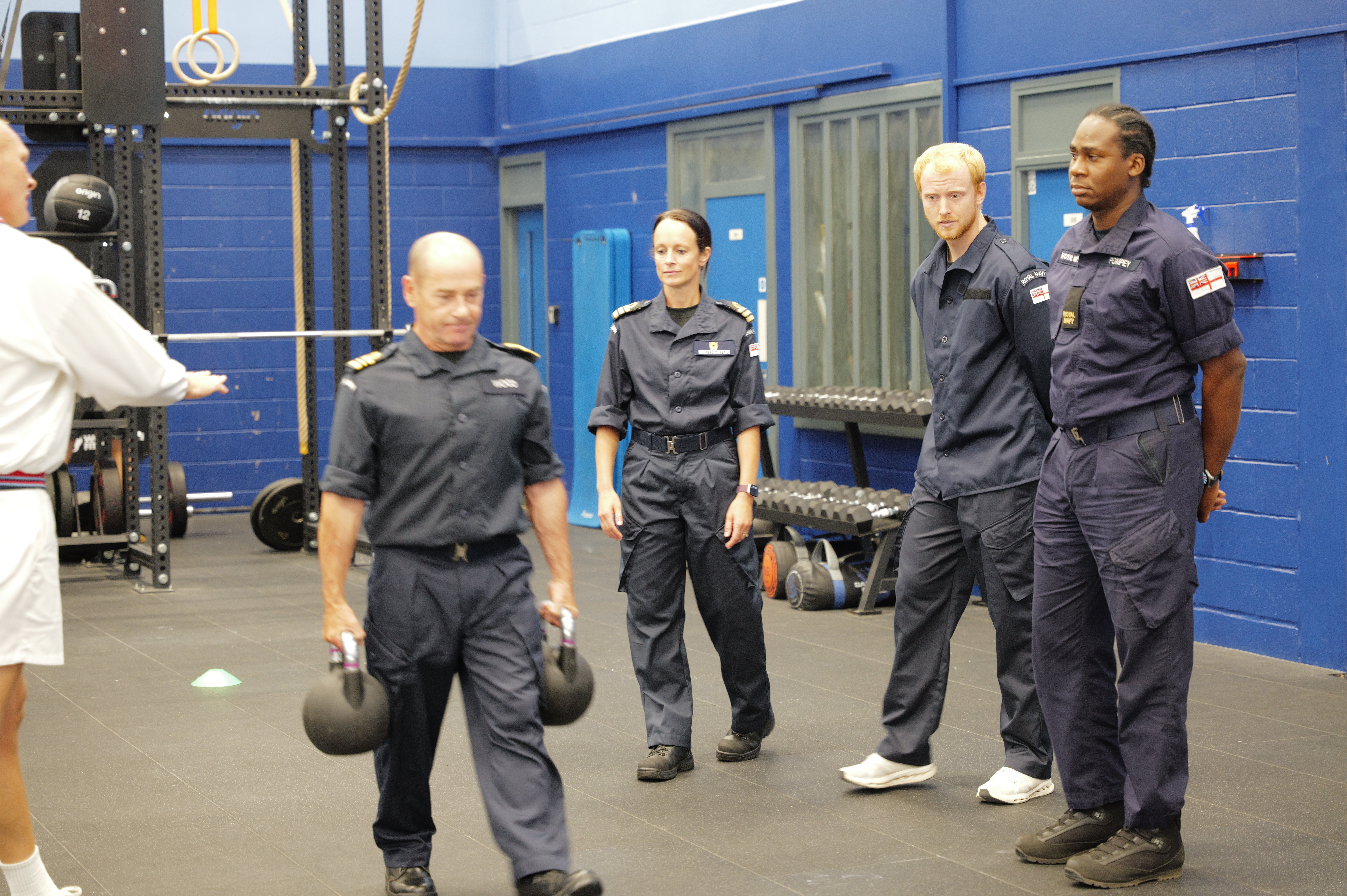
Finally, it’s my turn, and the 15-minute countdown begins. The 60m kettlebell carry comes first, and it goes off without a hitch. The distance is shorter and the weights are lighter than those in a HYROX race – one of my prior fitness challenges – so the carry feels manageable in comparison.
The only slight curveball is the 12-or-so inch hurdle halfway along the 15m there-and-back track, which is designed to mimic the raised metal door hatch you might encounter on a ship. As a clumsy person by nature, I make sure to exaggerate my steps when navigating it, and manage to avoid clipping it with each traverse.
Station two: Powerbag lift x20 (moving a 20kg powerbag between an 18in box and a 48in box – there and back is one rep)
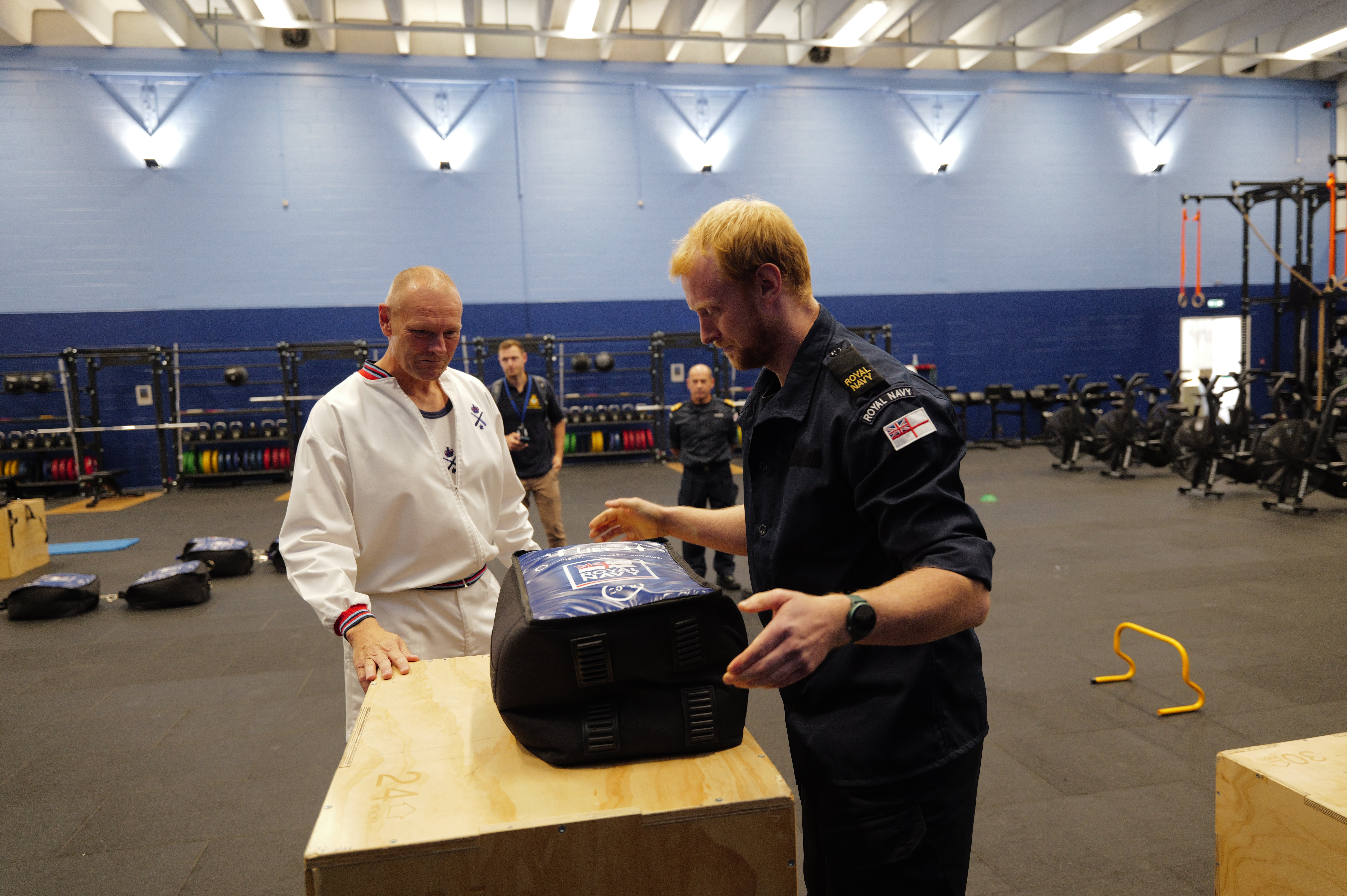
Second is the powerbag lift, replicating the demands of moving equipment up a ladder. AB Pompey made this look effortless, but after moving it between the boxes 10 times I’m getting a little hot under my (not inconsiderable) woollen collar. The 20kg powerbag is without handles and slightly awkward to move, but thankfully it’s light enough to grip and rip for the full 20 reps.
Station three: Kettlebell deadlift x12 (40kg kettlebell)
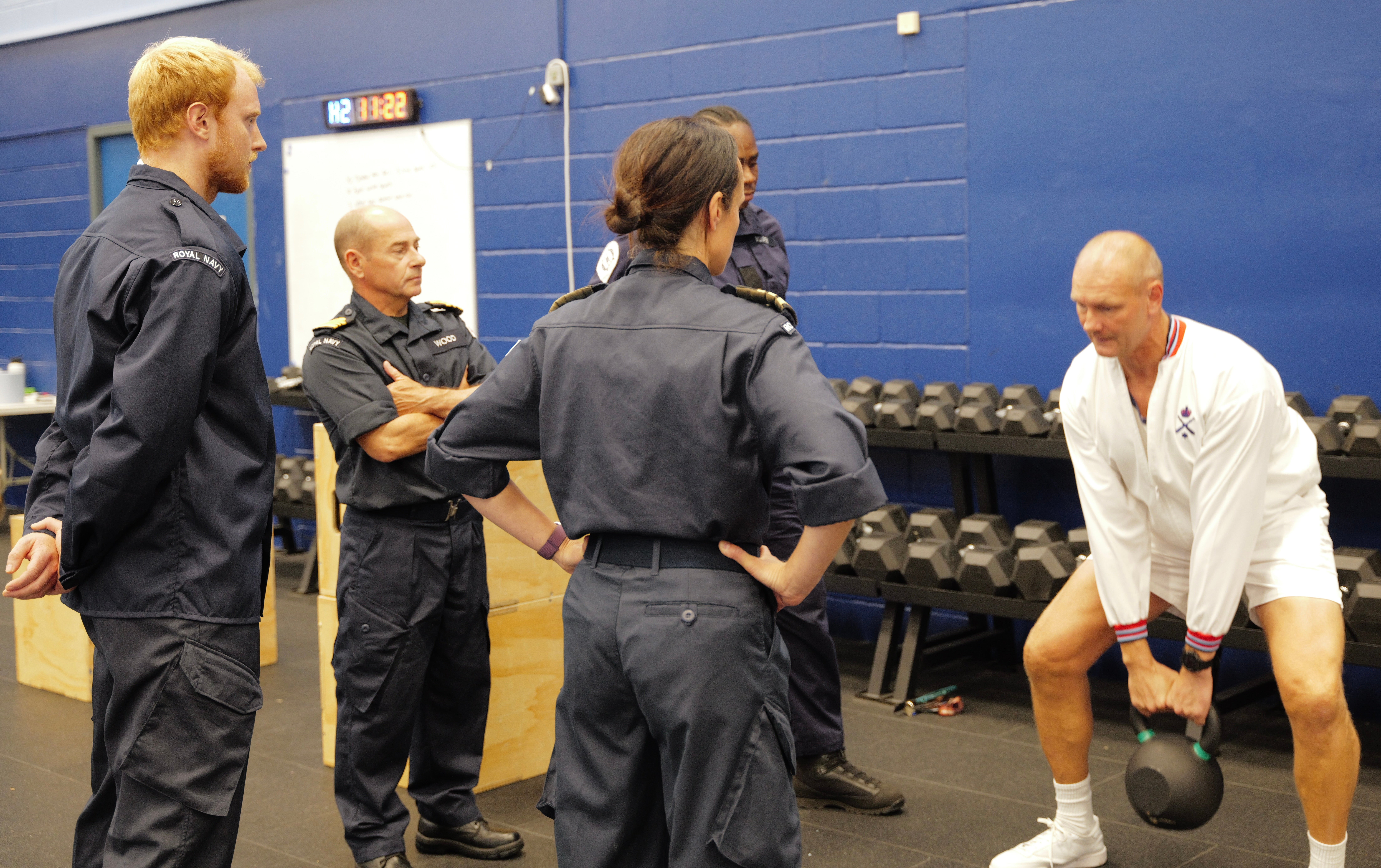
After placing the powerbag down for the final time, I move to the chunky 40kg kettlebell for the deadlifts. Here, a timer plays a series of beeps to tell me when to lift, hold and lower the weight. The lift is fast, the hold at the top of the movement lasts for three seconds, then the weight is lowered under control.
Adhering to the beeps, the kettlebell barely touches the ground before it’s time to lift it again. This tested my grip as much as anything, particularly after the prior two challenges. But the weight was still relatively light compared to the barbell deadlifts I’m used to in the gym, so I was able to hold on for the prescribed 12 reps.
Station four: Rope pull x6m (pulling 2x30kg powerbag, attached as one)
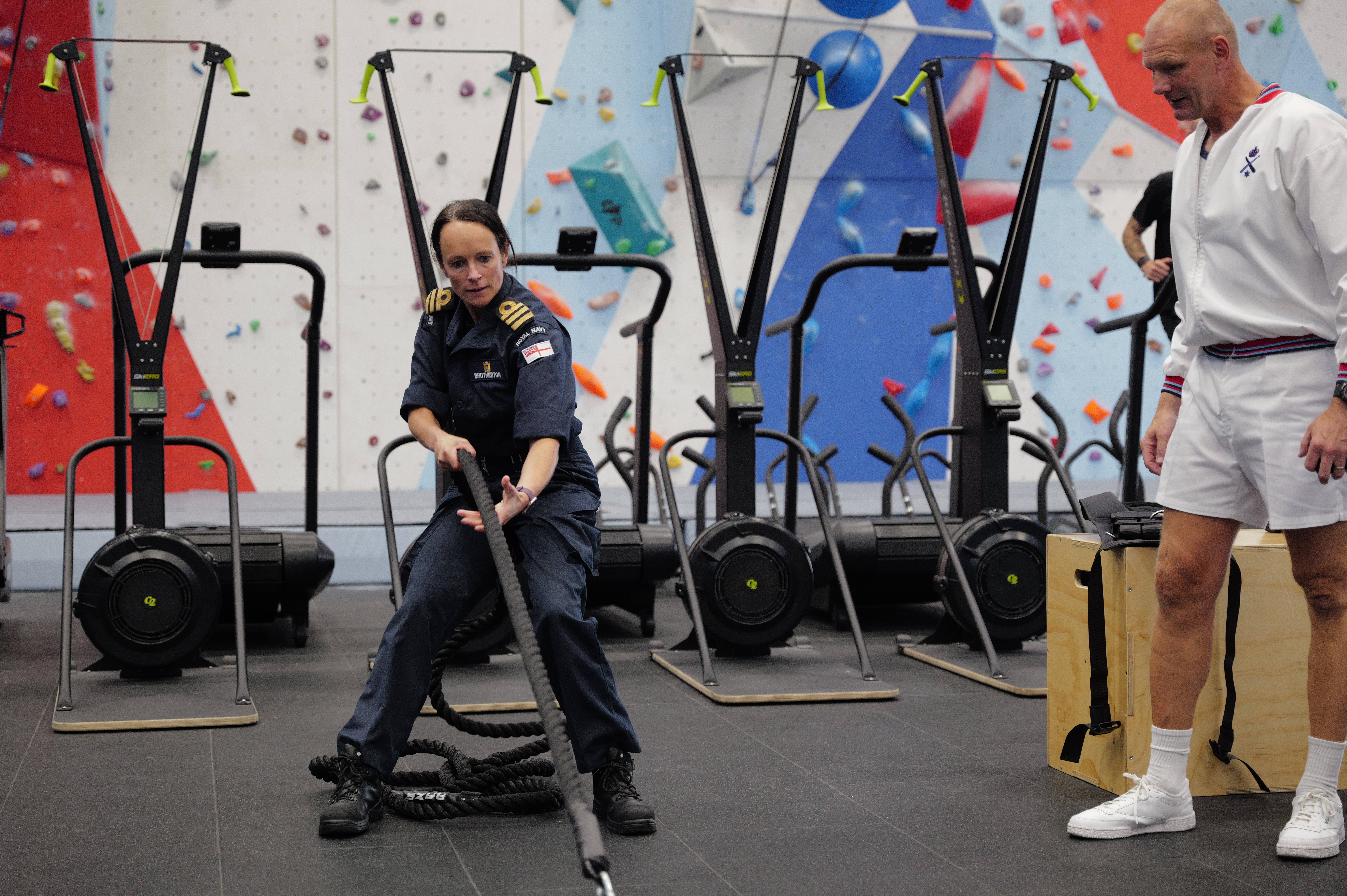
The test had proved remarkably grip-heavy up to this point, which makes sense when sailors are required to carry heavy equipment to and fro on board ships. This trend continued with the next station, the rope pull, which challenged me to drag a couple of 30kg powerbags six metres across the gym floor.
Grabbing the rope, I was initially concerned that the rubber gym flooring (uniform among test centres) might generate a lot of friction and stop the powerbags in their tracks. I sunk into a partial squat, braced myself, then gave a forceful heave to get things going. To my relief, the bags jolted forward, and I was able to keep this momentum going for the remainder of the 6m route.
Station five: Alternating lunges x12 (7.5kg dumbbell and 20kg weighted vest)
My reward for completing the first four stations? For the remainder of the test, I’m required to wear a 20kg weighted vest.
Despite this and a 7.5kg dumbbell in one hand, the lunges feel fine. The slightly alien feel of the weighted vest throws off my balance slightly, testing my stability more than my strength, but I emerge unscathed.
Station six: Casualty drag x15m (4x20kg powerbag, attached as one)
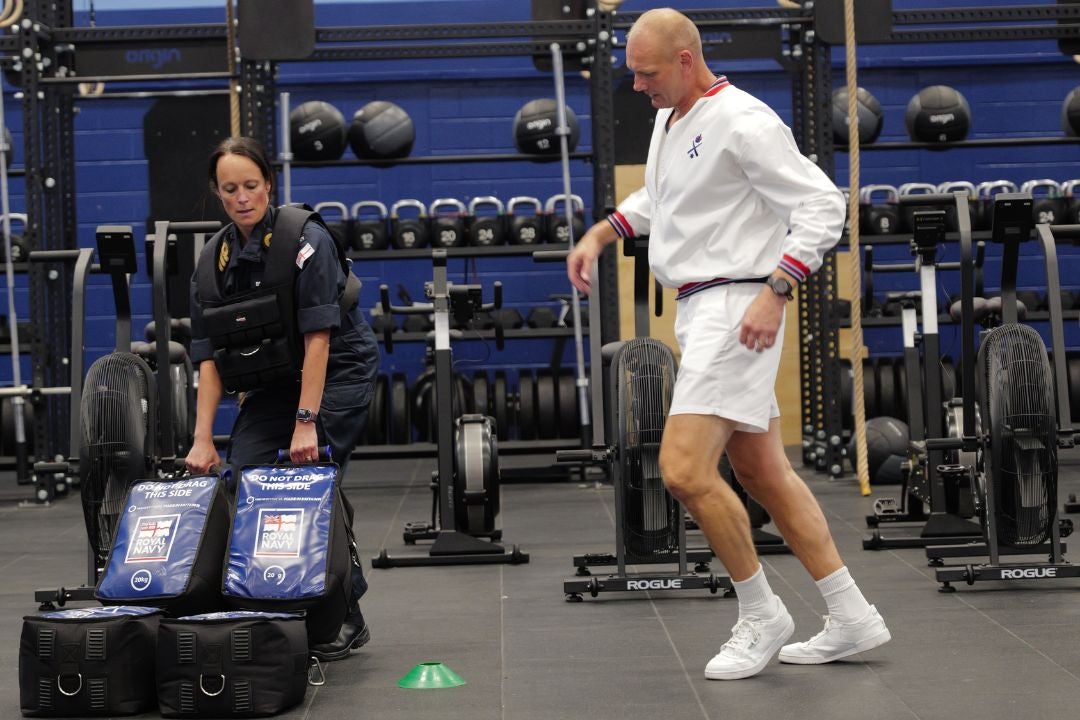
I’m also able to move through the casualty drag fairly smoothly. Though shifting 80kg is no mean feat, the fact it’s being dragged means you are never supporting the full weight in one go.
The there-and-back course is 7.5m long in each direction, and rounding a cone at one end without knocking into it requires a dash of precision driving. But other than this, the station is surprisingly enjoyable.
Station seven: Kettlebell carry x60m (2x20kg kettlebell and 20kg weighted vest)
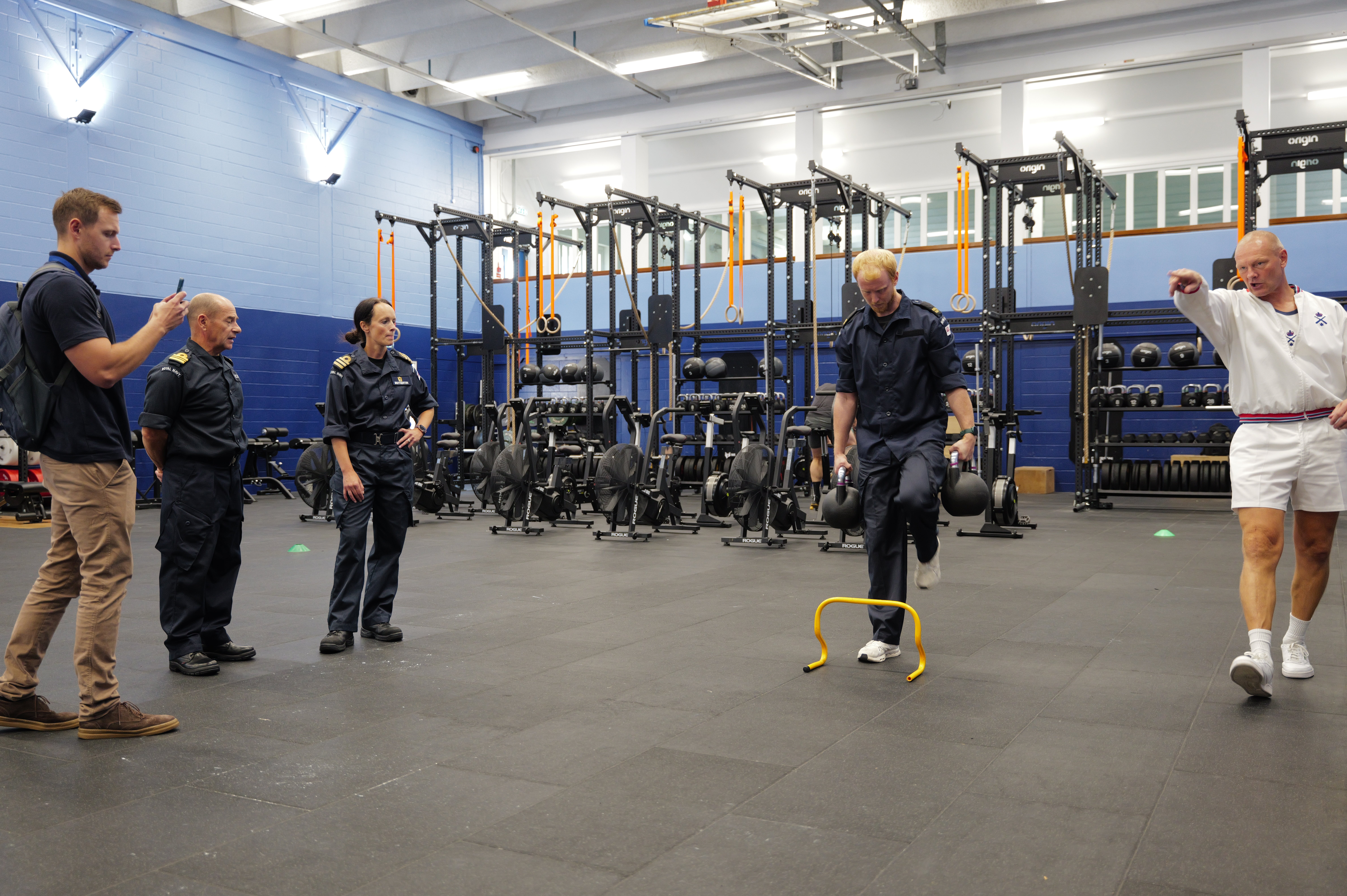
Finally, I round off the test with another 60m kettlebell carry. Despite the addition of a weighted vest, it proves to be plain sailing and I’m able to complete the test.
As I stand at the finish line, a slick sheen forming on my forehead and heat pouring from the sleeves and collar of my heavy uniform, Daz informs me I wrapped things up in roughly six minutes – a pass.
My thoughts on the Royal Navy fitness test
I was lucky here. At 6ft 2in and roughly 90kg, the test played into my physiology – as Wood says, “mass moves mass”. For this reason, the weights involved were relatively manageable compared to those I might train with in the gym, and I was able to move them without too much difficulty.
This might disappoint those that clicked on this article to see me suffer through an intense military fitness test. But it’s important to note the function of the test as a “physical employment standard” – an assessment designed to make sure sailors have the entry-level fitness needed to represent the organisation.
There will be further tests of fitness for those involved in the Royal Navy’s various sports associations, and many sailors will choose to surpass these minimum standards required of them. This test simply establishes a practical lowest common denominator for physical capacity. I also appreciated how each element of the test is designed to emulate the demands you might face during an emergency on board a ship.
“Whether you’re male or female, and no matter your age, if you’re deployed on operations the public expect their military to be able to perform at a certain physical level,” says Wood. “To design the test, it was a question of: ‘what can we rally around in the Navy?’ We’re not all pilots, we’re not all mariners, some of us do gunnery, some of us drive ships, but we can all rally around battle damage.
“If we get bombs or missiles coming into the ship, there is going to be battle damage, and we need to be able to carry out damage control – trying to fight fires, plug the holes and stop water coming into the ship.”
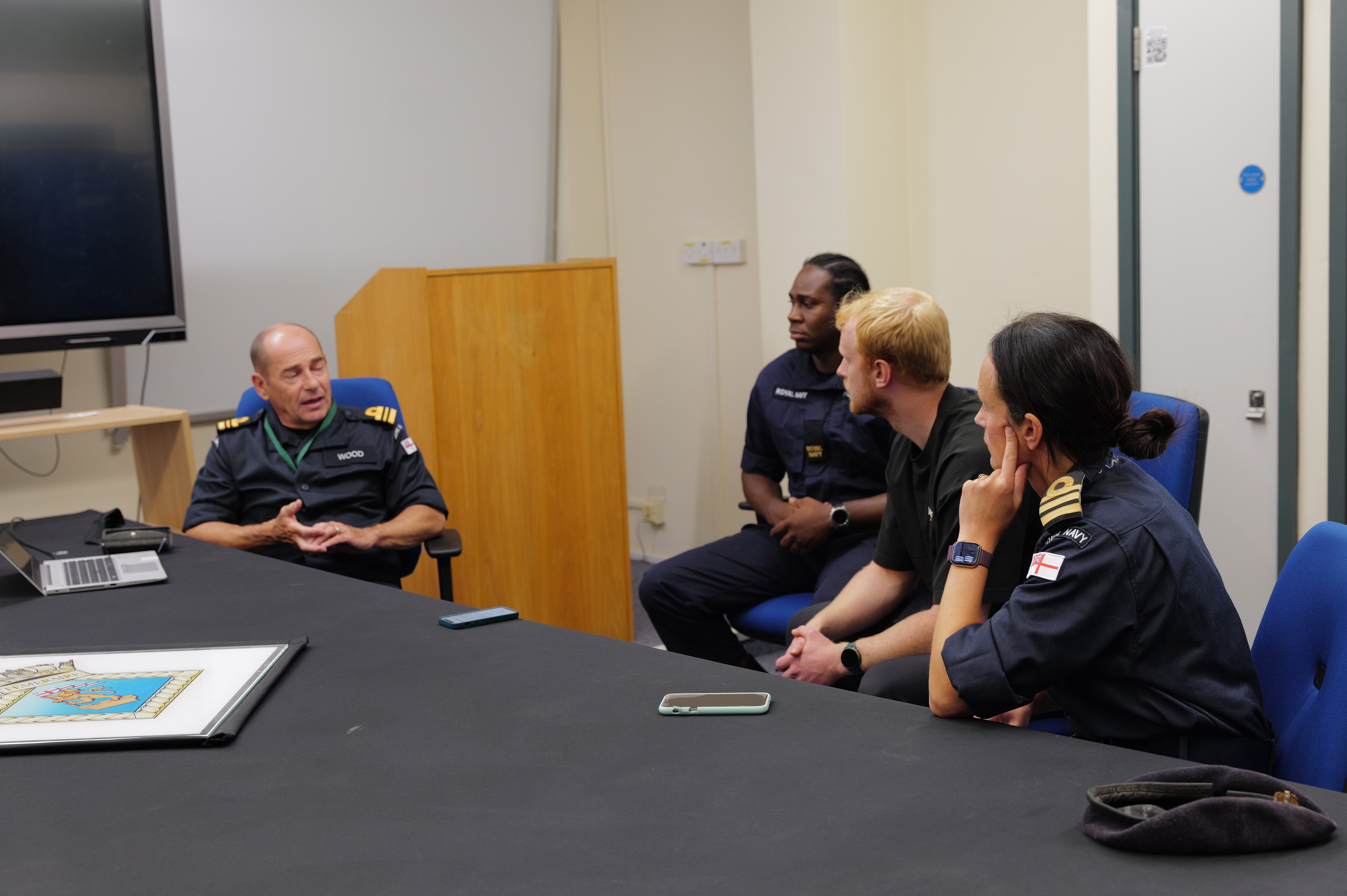
AFFF canisters carry foam for extinguishing fires, so 20kg powerbags are included in the assessment to replicate them. The same applies for the powerbag drag, which requires you to move 80kg to echo the average weight of a casualty, while the lunge mimics the “movement profile of firefighting”.
These weights will be manageable for many sailors. However, there are those who may struggle to pass the PES test, and they can be placed into two main groups: those with low levels of strength and fitness, or those who are incredibly aerobically fit – and might have thrived during a 1.5 mile run – but are not particularly familiar with strength training.
“We found quite a lot of people who are very, very good runners were a bit worried because this test is more ‘shift it and lift it’,” says Hoare.
Some sailors feared the new strength elements might be beyond their capabilities. However, the test needs to identify physiques fit for service aboard a ship, and I’m told many people have surprised themselves with the weights they are able to lift while taking the assessment.
“If you can move medium weights relative to your body shape, there’s a lot of benefit,” says Wood. “If you practise it, your body will adapt and you will improve.”
Read more: Five stretches you should be doing every day according to a flexibility expert
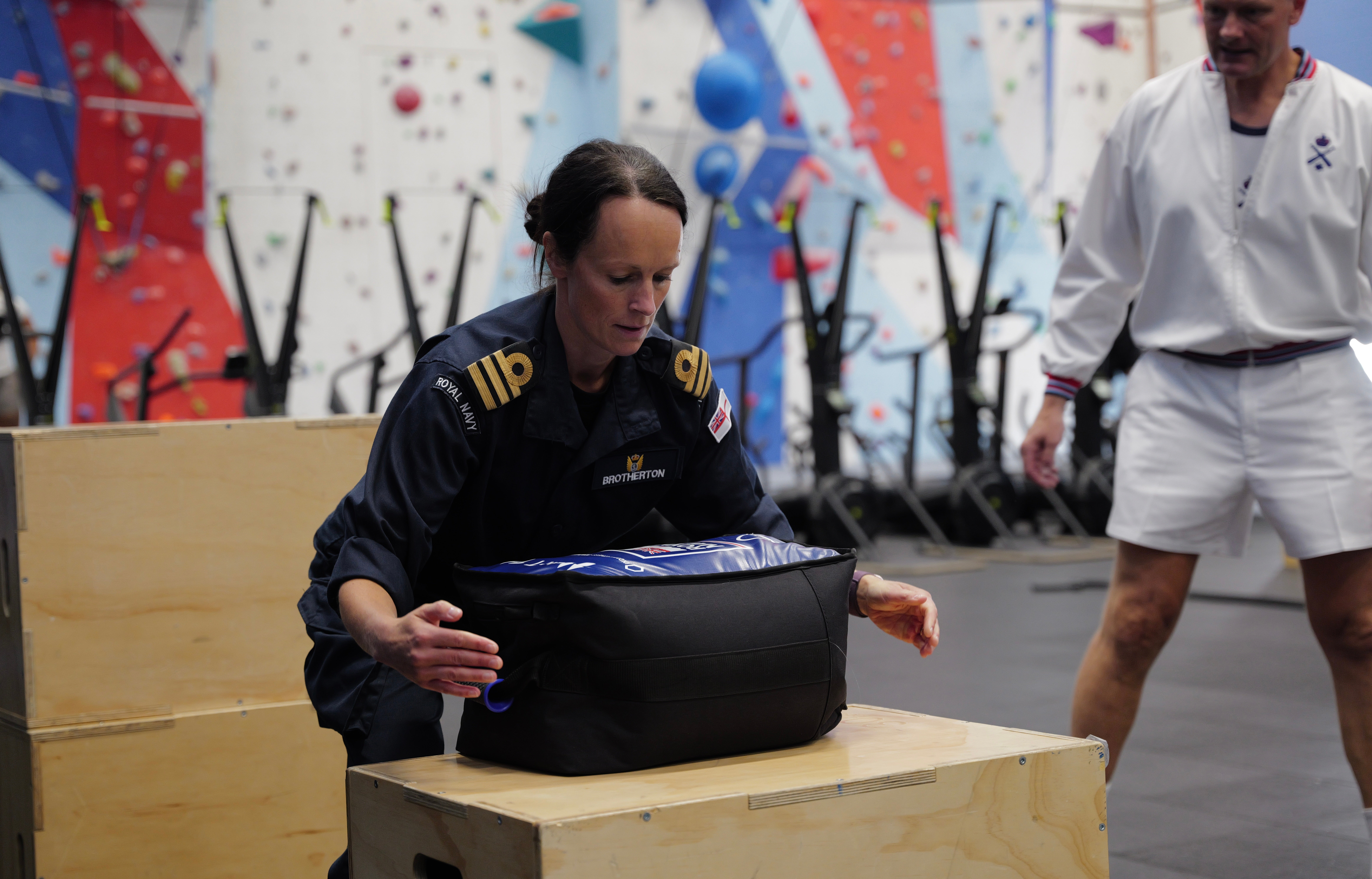
How was the new Royal Navy fitness test designed?
The rationale behind introducing the new Royal Navy fitness test is specificity. If there is an emergency on board a ship, a foundation of strength, muscular endurance and mobility is necessary to haul heavy firefighting equipment around.
The test was designed based on a NATO framework on the development of physical employment standards. This started with identifying the most critical and physically demanding parts of the job, Dr Steve Powell, Head of Applied Physiology at the Institute of Naval Medicine, tells me.
“Of those tasks, you can objectively analyse how physically demanding they are through things like oxygen consumption and heart rate analysis,” he explains. “We had people on board a ship conduct them in a standardised way, then measured the physiological demands of each task.
“We then took the most demanding and used them to inform the design of the test. It is a very logical process that ensures the test that personnel are required to do on an annual basis directly reflects the demands of the job that they may be exposed to in the case of an emergency on board a ship.”
The other criterion the new PES test had to hit was practicality. For this reason, leaders worked to design a test that could be completed within an hour, paperwork and all. This is in stark contrast to some other military fitness assessments which can take upwards of four hours – a considerable undertaking when tens of thousands of people are required to take it every year.
“We don’t want the test to be an administrative burden for the Navy – we want it to support the Navy, not cause the Navy a headache,” Wood adds. “To get a ship to sea, a helicopter to fly or a submarine deployed is a massive undertaking, so we were very aware of that when we developed the policy.”
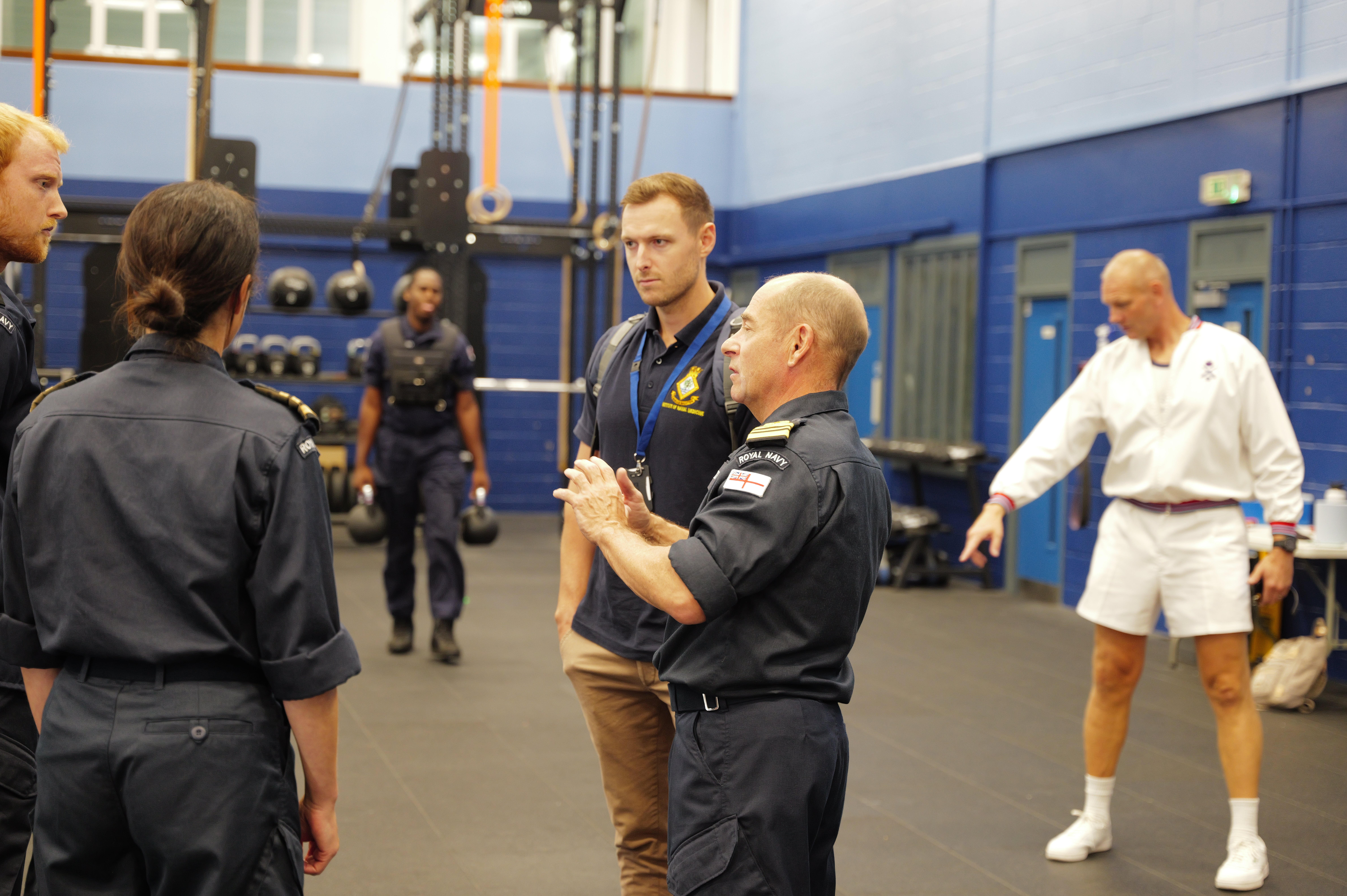
How many people pass the Royal Navy physical employment standards test?
The physical employment test is designed to ensure people have the minimal level of fitness to be employed in the Royal Navy. As such, one of the concerns when designing it was that too many people might fail.
“The test has to be as fair as possible, but also robust,” Wood says. “We’re really pleased with where we are with the statistics. As of 2 September 2025, it will have been going for a year. Close to 90 per cent of people in the Navy have done the test, and we’ve got the failure rate down to 0.35 per cent. There is a slightly higher percentage within the female population – about 2 per cent.
“People will have the chance to take the test whenever they like, and if they fail it they need to go on a 12-week gym-based conditioning programme, although depending on their fitness they don’t have to start on week one.”
Through this, most people who failed the test on the first time of asking have been able to retake it and pass within a couple of months. Due to the new strength elements, Wood also recognises that stronger, heavier applicants have an advantage going in.
“Does [passing this test] mean they're healthy? Not necessarily,” he says. “Does it mean it's going to solve obesity? It's not going to solve obesity.
“We recruit from the civilian population, where weight is generally going up and health is decreasing. [The test] can't solve those problems, but it prepares people for operations and additionally supports health and wellbeing.”
9 best kettlebells for building strength and fitness at home, tested by our expert
I tried a CrossFit Games champ’s three-move workout – it left me struggling to climb the stairs
The fitness shortcuts that can still deliver healthy results
Millie Mackintosh on the life changing moment she decided to go sober
The midlife health tests every man should have (and the symptoms to never ignore)

